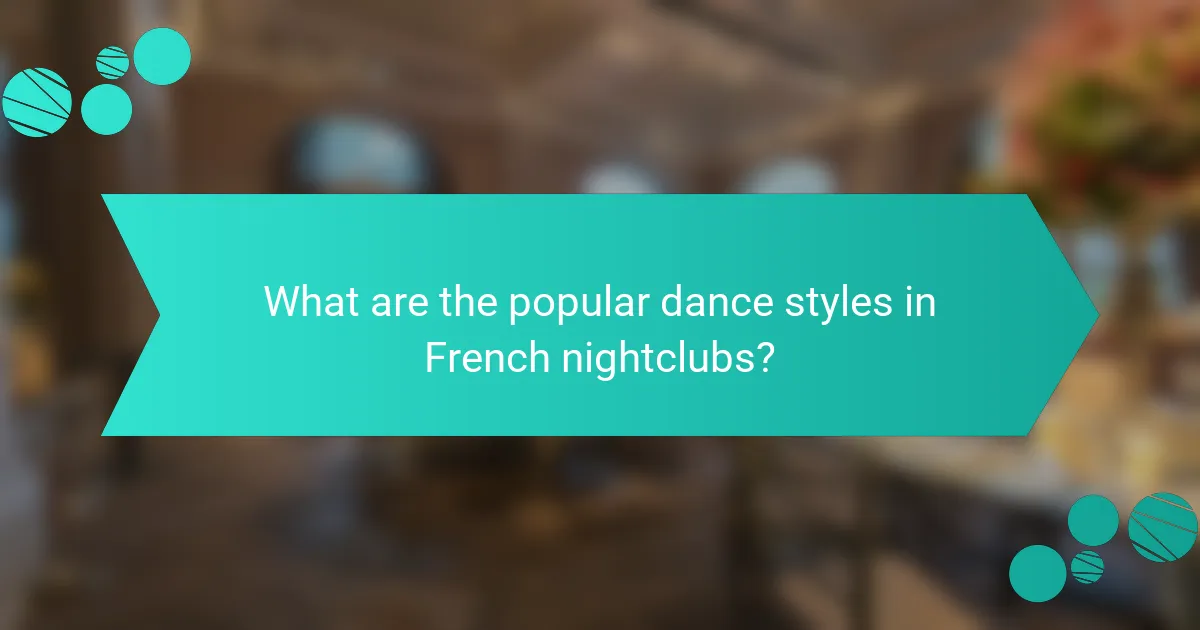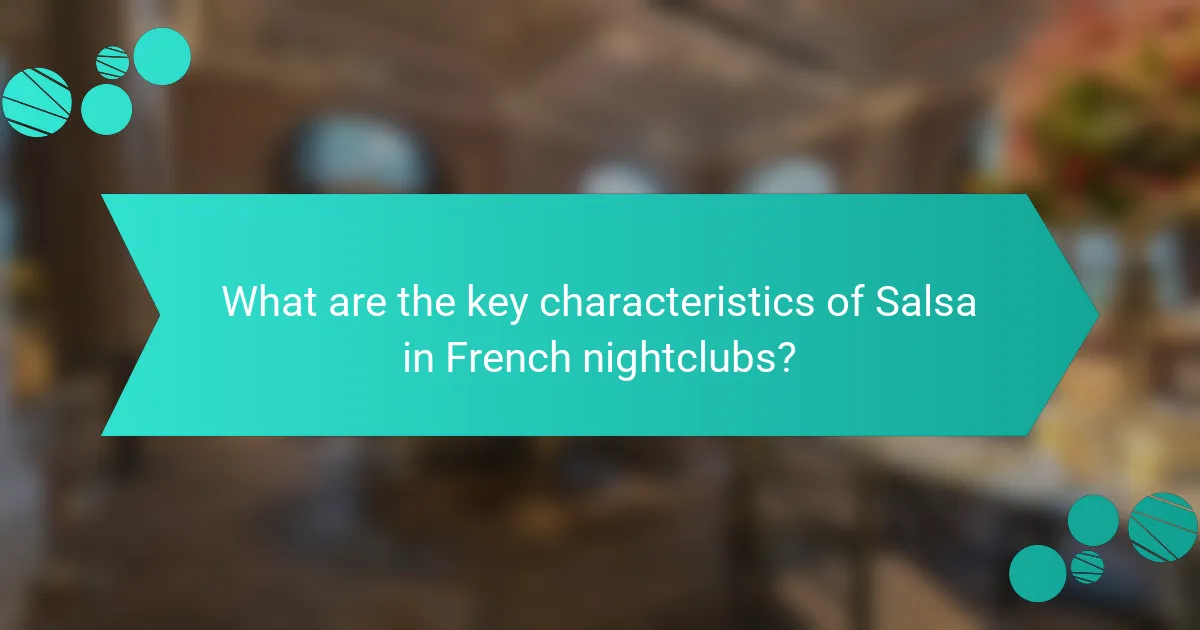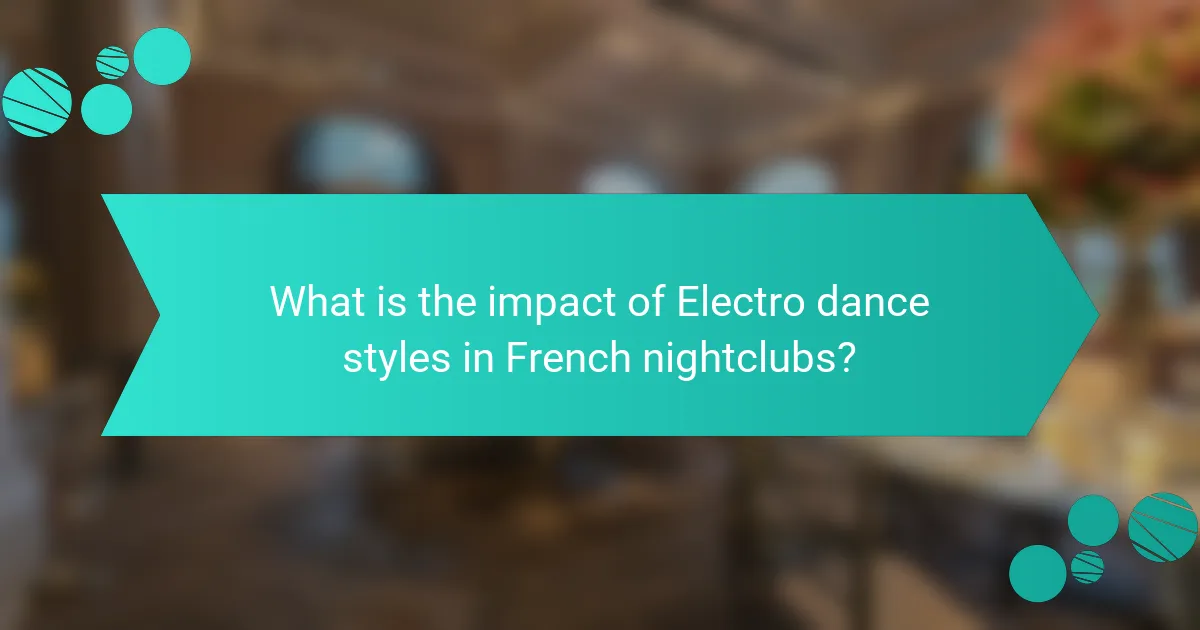The article explores popular dance styles in French nightclubs, focusing on house, techno, salsa, hip-hop, and electro. Each style contributes uniquely to the vibrant nightlife scene, with house music characterized by repetitive beats, while techno offers synthetic sounds and immersive rhythms. Salsa combines Afro-Cuban influences with lively partner dancing, and hip-hop introduces expressive street-style movements. Additionally, electro dance styles create an energetic atmosphere that fosters social interaction and individual expression. The article highlights the cultural diversity and community spirit that these dance styles bring to French nightlife.

What are the popular dance styles in French nightclubs?
Popular dance styles in French nightclubs include house, techno, salsa, and hip-hop. House music features repetitive beats and is widely embraced for its energetic vibe. Techno is characterized by its synthetic sounds and driving rhythms, often creating an immersive experience. Salsa, with its lively tempo, encourages partner dancing and is popular during Latin-themed nights. Hip-hop brings street-style movements and is favored for its expressive nature. These styles reflect the diverse musical landscape in French nightlife, catering to various tastes and preferences.
How did these dance styles evolve over time?
Dance styles in French nightclubs evolved through cultural exchange and social influences. Salsa emerged in the 1960s, blending Afro-Cuban rhythms with jazz and rock influences. Electro dance evolved in the 1980s, driven by the rise of electronic music and technology. Each style adapted to the changing musical landscape and audience preferences. The integration of hip-hop in the 1990s introduced new movements and techniques. Additionally, globalization facilitated the fusion of various dance forms. Social media in the 2000s further accelerated the spread and evolution of these styles. Today, French nightclubs showcase a diverse range of dance styles, reflecting their rich historical evolution.
What historical influences shaped these dance styles?
Historical influences that shaped popular dance styles in French nightclubs include cultural exchanges, migration patterns, and social movements. Salsa originated from Afro-Cuban rhythms and was influenced by jazz and swing music in the early 20th century. The arrival of Caribbean immigrants in France during the 1950s popularized salsa in Paris. Electro music emerged in the 1980s, influenced by the rise of electronic instruments and the disco movement. The social revolution of May 1968 in France also played a role in shaping dance culture, promoting freedom of expression. These historical contexts created a rich tapestry of influences that defined dance styles in French nightclubs.
How have cultural exchanges impacted their development?
Cultural exchanges have significantly influenced the development of popular dance styles in French nightclubs. These exchanges have introduced diverse rhythms and movements from various cultures. For example, salsa, originating from Latin America, has blended with French music styles. This fusion has created unique dance forms that reflect both cultural heritages. Additionally, the influence of electronic music has transformed traditional dance practices. The collaboration between artists from different backgrounds has led to innovative choreography. Dance competitions and festivals have further promoted this cultural interchange. Such events showcase a variety of dance styles, enriching the nightclub scene in France. Overall, cultural exchanges have fostered creativity and diversity in dance, shaping its evolution in French nightlife.
What role do these dance styles play in French nightlife?
Dance styles play a significant role in French nightlife. They enhance social interaction and cultural expression among participants. Popular styles like salsa and electro create vibrant atmospheres in nightclubs. These dance forms encourage community building and connection among diverse groups. Furthermore, they reflect France’s rich cultural tapestry and history. The rhythmic movements and music foster a sense of liberation and joy. Studies indicate that dance improves mood and promotes physical activity in nightlife settings. Overall, these dance styles are central to the nightlife experience in France.
How do they contribute to the overall atmosphere of nightclubs?
Dance styles contribute significantly to the overall atmosphere of nightclubs. They create an engaging environment that encourages social interaction. Popular styles like salsa and electro generate vibrant energy on the dance floor. This energy attracts people and enhances the nightlife experience. The rhythm and movement of dance styles can influence mood and emotions. Research shows that music and dance increase dopamine levels, fostering joy and excitement. Consequently, the presence of diverse dance styles enriches the nightclub experience. This leads to memorable nights and a lively ambiance.
What social dynamics are involved in these dance styles?
Dance styles in French nightclubs involve various social dynamics. These dynamics include interaction, community building, and cultural exchange. Dancers often engage in partner work, fostering connection and communication. The atmosphere encourages socialization and networking among participants. Different dance styles reflect diverse cultural backgrounds, promoting inclusivity. Events often serve as a platform for artistic expression and identity exploration. Additionally, the music influences mood and behavior, shaping the overall social experience. Studies show that dance fosters social cohesion and enhances group identity.

What are the key characteristics of Salsa in French nightclubs?
Salsa in French nightclubs is characterized by vibrant energy and rhythmic music. The genre combines Afro-Cuban influences with contemporary Latin sounds. Dancers often engage in partner work, showcasing intricate footwork and spins. The atmosphere is typically lively, encouraging social interaction among attendees. Many nightclubs feature live bands or DJs playing salsa tracks. Events often include dance lessons, attracting both beginners and experienced dancers. The cultural diversity of participants enriches the experience, blending various styles and interpretations. French nightclubs often host themed salsa nights, enhancing the overall appeal.
How is Salsa typically performed in these venues?
Salsa is typically performed in venues through energetic partner dancing. Dancers often engage in intricate footwork and body movements. The music features a lively rhythm that enhances the dance experience. Couples frequently execute spins, turns, and dips as part of their routine. Salsa dancing promotes improvisation, allowing dancers to express their individuality. Venues often have dance floors that encourage social interaction. Dance instructors may offer lessons to beginners in these settings. Many nightclubs host salsa nights to attract enthusiasts and create a vibrant atmosphere.
What are the basic steps and movements in Salsa dancing?
The basic steps in Salsa dancing include the forward and backward basic step, side step, and cross-body lead. The forward basic step involves stepping forward with one foot while shifting weight, then returning to the starting position. The backward basic step mirrors this, with one foot stepping back and weight shifting. The side step consists of stepping to the side and bringing the feet together. The cross-body lead allows one partner to lead the other across their body, creating a dynamic movement. These movements form the foundation of Salsa and are essential for beginners.
What music genres are commonly associated with Salsa in nightclubs?
Salsa in nightclubs is commonly associated with genres like Latin jazz, merengue, and bachata. These genres complement the rhythmic and energetic nature of salsa music. Latin jazz incorporates improvisation and syncopated rhythms, enhancing the salsa experience. Merengue features a fast-paced beat that encourages lively dance movements. Bachata, with its romantic melodies, adds a different flavor to salsa nights. Together, these genres create a vibrant atmosphere in nightclubs. This mix of styles keeps dancers engaged and showcases the diversity of Latin music.
What are the cultural significance and origins of Salsa?
Salsa is a dance with deep cultural significance and rich origins. It emerged in the Caribbean, particularly in Cuba, during the late 19th century. The dance blends African rhythms with Spanish melodies, reflecting the diverse cultural heritage of the region. Salsa became popular in the United States during the 1960s, especially in New York City, where it evolved further. The genre incorporates various styles, including Son, Mambo, and Rumba. Salsa music and dance serve as vital expressions of identity and community among Latin American populations. The dance is celebrated for its improvisational elements, allowing personal expression. Salsa festivals and competitions highlight its global appeal and cultural importance.
How does Salsa reflect the cultural diversity of France?
Salsa reflects the cultural diversity of France through its blend of Latin American and Caribbean influences. This dance form originated in the Caribbean, particularly Cuba and Puerto Rico, and has been embraced by various communities in France. The vibrant rhythms and styles of salsa have attracted dancers from different ethnic backgrounds.
In cities like Paris, salsa clubs often feature a mix of cultures, showcasing the integration of immigrant communities. Events such as salsa festivals highlight this multicultural exchange, drawing participants from diverse origins. The popularity of salsa in France illustrates the nation’s openness to global cultural expressions.
Moreover, salsa’s evolution in France has led to the emergence of unique styles that incorporate local dance elements. This adaptability further emphasizes how salsa serves as a cultural bridge among different groups. Overall, salsa embodies the rich tapestry of France’s cultural diversity.
What are the common misconceptions about Salsa dancing?
Salsa dancing is often misunderstood as being solely a partner dance. Many believe it requires extensive prior experience or training. In reality, beginners can quickly learn basic steps and enjoy the dance. Another misconception is that salsa dancing is only for Latin music. Salsa can be danced to various music styles, including pop and jazz. Some think salsa is only performed in formal settings. However, it is commonly enjoyed at social gatherings and clubs. Additionally, many assume salsa is only for young people. People of all ages participate in salsa dancing worldwide. These misconceptions can deter individuals from trying salsa. Understanding the truth can encourage more people to embrace this vibrant dance form.

What is the impact of Electro dance styles in French nightclubs?
Electro dance styles significantly shape the atmosphere in French nightclubs. They create an energetic environment that encourages social interaction. The pulsating beats of electro music drive people to dance and express themselves freely. This genre often features improvisational movements, allowing dancers to showcase their individuality. French nightclubs have embraced electro dance as a staple since the early 2000s. Events featuring electro dance styles attract diverse crowds, fostering a sense of community. The popularity of electro dance has influenced the overall nightlife culture in France. It has led to the emergence of dedicated dance events and festivals celebrating this style.
How does Electro dance differ from traditional styles?
Electro dance is distinct from traditional dance styles primarily due to its emphasis on rapid, sharp movements and electronic music. Traditional styles often incorporate fluid, graceful motions and are typically performed to live or acoustic music. Electro dance features a unique combination of isolation techniques and robotic movements, which are less common in traditional forms. This style emerged in the late 1980s and is heavily influenced by the electronic music scene, particularly techno and house. Unlike traditional dances, which may have set steps or patterns, Electro dance allows for more improvisation and personal expression. The use of visual effects and lighting in Electro dance performances also sets it apart from traditional styles. Overall, the energetic and dynamic nature of Electro dance creates a distinct experience that contrasts with the more structured formats of traditional dance.
What are the defining movements and techniques of Electro dance?
Electro dance is characterized by sharp, quick movements and fluid body isolation techniques. The defining movements include the “tutting” technique, which involves creating geometric shapes with the arms and hands. Another key movement is the “waving,” where dancers create a flowing motion that resembles a wave traveling through the body. Additionally, “locking” is used, which involves freezing in place and then quickly transitioning to another pose. The dance style often incorporates footwork that is rhythmic and syncopated, enhancing the overall visual effect. Electro dance is performed to electronic music, emphasizing beats and tempo. Its origins trace back to the late 1980s and early 1990s, particularly in France, where it evolved in dance clubs. The combination of these techniques creates a distinctive style that is both energetic and visually captivating.
What role does technology play in Electro dance performances?
Technology enhances Electro dance performances by integrating music, visual effects, and interactive elements. It allows for synchronized lighting and sound systems, creating immersive experiences. Digital platforms enable dancers to share choreography and connect globally. Performance software can generate real-time visual effects that respond to music. Additionally, wearable technology can track movement and enhance choreography. The use of social media facilitates audience engagement and promotes events. These technological advancements have transformed how Electro dance is performed and experienced.
What are the popular sub-genres of Electro dance in France?
The popular sub-genres of Electro dance in France include Electro House, Dubstep, and French Touch. Electro House features heavy bass and upbeat rhythms, making it a staple in clubs. Dubstep is characterized by its wobbly basslines and syncopated beats, appealing to a younger audience. French Touch is known for its disco influences and melodic elements, originating in the 1990s. These sub-genres have shaped the French electronic music scene significantly. Festivals like Tomorrowland and Paris Electronic Week showcase these styles, highlighting their popularity.
How do these sub-genres influence the nightclub experience?
Sub-genres of music significantly influence the nightclub experience by shaping the atmosphere and energy. Each sub-genre, such as salsa or electro, brings its own unique rhythm and style. For instance, salsa encourages lively, energetic dancing, creating a vibrant social environment. Electro, on the other hand, often features pulsating beats that foster an immersive experience.
The choice of sub-genre affects the crowd’s demographics and behavior. Salsa nights may attract a diverse audience interested in cultural expression. Electro events might appeal to younger, tech-savvy patrons seeking a modern vibe.
Additionally, the sub-genres dictate the DJs’ mixing styles and track selections. A DJ playing salsa will incorporate traditional instruments and rhythms, while an electro DJ may use synthesizers and digital effects. This variation in sound directly impacts how people interact on the dance floor.
Overall, the influence of sub-genres shapes the overall ambiance, crowd interaction, and the type of experience patrons have in nightclubs.
What are the emerging trends in Electro dance styles?
Emerging trends in Electro dance styles include the integration of diverse music genres. Dancers are incorporating elements from hip-hop, house, and techno. This fusion creates a dynamic and eclectic dance experience. Another trend is the use of technology in performances. Dancers utilize visual effects and interactive lighting to enhance their routines. Social media platforms are also influencing dance styles. Dancers share choreography and tutorials online, fostering a global community. Additionally, improvisation is gaining popularity. Dancers are encouraged to express individuality and creativity in their movements. These trends reflect the evolving nature of Electro dance within nightlife culture.
What tips can enhance your experience with these dance styles?
To enhance your experience with dance styles in French nightclubs, focus on practicing regularly. Regular practice helps improve your technique and confidence. Engage with experienced dancers for tips and feedback. This can provide valuable insights and accelerate your learning. Attend workshops or classes dedicated to specific styles like Salsa or Electro. These structured environments foster skill development. Immerse yourself in the music associated with each dance style. Familiarity with the rhythm enhances your ability to express yourself. Lastly, maintain a positive attitude and enjoy the process. Enjoyment fosters a deeper connection to the dance.
How can beginners get started with Salsa and Electro dance?
Beginners can start with Salsa and Electro dance by taking introductory classes. Many dance studios offer beginner-friendly sessions. These classes teach basic steps and rhythms. Practicing regularly is essential for skill improvement. Joining local dance groups can provide additional support and motivation. Online tutorials are also available for self-paced learning. Attending social dance events helps in gaining practical experience. Engaging with the dance community fosters connections and enhances learning.
What are some common etiquette rules in French nightclubs for dancers?
Common etiquette rules in French nightclubs for dancers include respecting personal space. Dancers should avoid invading others’ personal areas without consent. Maintaining a positive attitude is essential. Smiling and engaging with others enhances the atmosphere. Dressing appropriately is also important. Nightclubs often have specific dress codes that should be followed. Additionally, dancers should refrain from excessive talking on the dance floor. This allows everyone to enjoy the music and space. Lastly, acknowledging the DJ and performers is a sign of respect. This creates a supportive environment for all involved.
The main entity of the article is popular dance styles in French nightclubs, focusing on genres such as Salsa and Electro. The article explores the evolution of these dance styles, highlighting their historical influences and cultural exchanges that have shaped their development. It discusses the social dynamics involved in these dance forms and their impact on the overall atmosphere of nightclubs. Additionally, the article covers the characteristics and techniques of Salsa and Electro dance, common misconceptions, and tips for beginners, providing a comprehensive overview of the vibrant dance culture in French nightlife.